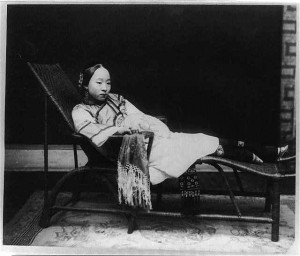
“Woman with bound feet reclining on chaise lounge, China”
Date: between 1890 and 1923
Medium: 1 photographic print.
Found in the Library of Congress Prints and Photographs Division Washington, D.C. 20540 USA
URL: http://www.loc.gov/pictures/item/2001705601/
Between the seventeenth and twentieth century, foot binding played a critical role in Chinese female fashion culture. In her article, “A Bondage in Time: Footbinding and Fashion Theory,” . Dorothy Ko states, “the meanings of footbinding are historical and multiple; they are always constructed, hence always entangled with the politics of seeing”(5). The opinions and meanings developed about footbinding over the past four centuries have relied on the viewer and his or her personal perception. In her other article, “The Body as Attire,” Ko explains that footbinding was seen as a sign of civility and orderliness, served male interests, and was a beautiful embellishment of the body that lied in concealment.
This text represents a few of the most pervasive motivations and ideas associated with footbinding in the nineteenth and twentieth century. It captures the essence of social structure in China at a time when male dominance and masculinity relied heavily on female footbinding. This photo symbolizes many valued aspects of footbound women at the time; concealment, mysteriousness, elegance, and luxury.
Upon seeing this text, the viewer may question why the woman is sitting in a chair. Her feet are not featured dominantly in this image, however, this lack of emphasis signifies a key component of Chinese culture in the late nineteenth and early twentieth century. The photographer chooses to display the woman’s bound feet in a discrete manner in this text and one can interpret this decision as a method to represent the mysteriousness of footbinding culture. The photographer uses darkness around the bound feet strategically to proclaim this mysteriousness. In addition, intricately embroidered shoes cover her feet allowing the woman to conceal them.
how bout focus on the idea of perception and conduct a semiotic analysis: how is viewer’s perception of the bondfeet through this photographic display: denotations of the found feet, the clothing, the chair and the black/white photo ….
Women in the twentieth century were forced to work physically demanding jobs with crippled feet and foot binding and fashion culture disabled many from certain laborious tasks completely. Perhaps the photographer chose to portray this woman sitting, rather than standing, to symbolize her weaker state and subservience to men. This female weakness and sense of helplessness gave males a chance to further assert their masculinity and power. In her article, “The Body as Attire,” Dorothy Ko states, “the perceptions of women’s bound feet were integral to articulations of manhood and nationhood in late imperial China”(12).
Women with bound feet were respected and their decision to participate in the fashion system displayed their civility and political obedience. Rather than placing her feet on the floor, the photographer chooses to keep them elevated to display their value and elegance. Finally, this woman dressed in silk, rests on a chaise, symbolizing luxury and high class.
The photographer’s decision to place the woman on a chaise with bound feet in a dark and mysterious lighting further iterate male superiority and the mysterious nature of footbinding. In addition, the chaise and her silk clothing symbolize luxury and the upper class. Finally, his/her choice to cover the feet with delicately embroidered shoes further emphasizes the beauty of footbinding as a concealed practice.
Meg (:
